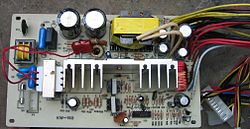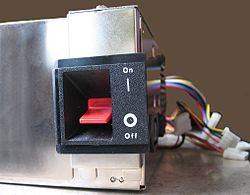Power supply unit
A power supply unit (PSU) is a part of the computer that converts alternating current (AC) to direct current (DC). Other parts of the computer need this DC power so that they can work. The PSU makes sure that the DC output voltage can be handled by these computer parts.[1]
Modern personal computers always use switched-mode power supplies, which has both efficiency advantages and makes designing for multiple voltage inputs easier. This means that most PSUs can operate in different countries where the power input might change. In the UK, the voltage is 240V 50Hz, whereas in the USA the voltage is 120V 60Hz, and in Australia it is 230V 50Hz. Some power supplies have a manual switch for selecting input voltage, while others automatically adapt to the mains voltage.
Most modern desktop personal computer power supplies conform to the ATX specification, which includes form factor and voltage tolerances. While an ATX power supply is connected to the mains supply, it always provides a 5-volt standby (5VSB) power so that the standby functions on the computer and certain peripherals are powered. ATX power supplies are turned on and off by a signal from the motherboard.[2]
Power Supply Unit Media
PCB of a power supply from an IBM XT clone
Voltage converter for 80486DX4 processors (5 V to 3.3 V). Note the heat sink on the linear regulator, required to dissipate the wasted power.
References
- ↑ "How to Choose Power Supply for PC: What to Know". Intel. Retrieved 2022-03-13.
- ↑ "ATX Motherboard". Elife PC. 2022-02-28. Retrieved 2022-03-13.








